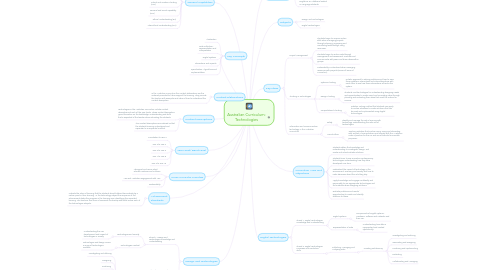
1. Cross Curricular Priorities
1.1. Aboriginal and Torres Strait Islander Histories and Cultures
1.2. Asia and Australia’s Engagement with Asia
1.3. Sustainability
2. Year Level/ Band Level
2.1. Foundation to Year 2
2.2. Year 3 to Year 4
2.3. Year 5 to Year 6
2.4. Year 7 to Year 8
2.5. Year 9 to Year 10
3. Content Descriptions
3.1. Technologies in the Australian Curriculum include content descriptions at each of the year levels. These content descriptors give information on the knowledge, understanding and skills that is expected of the teacher when educating the students.
3.2. The Content descriptions are ordered so that the students learning is developed and expanded in a sequential method.
4. Content Elaborations
4.1. In the Australian Curriculum the content elaborations are the materials provided to future support the learning. They provide the teacher with examples and ideas of how to understand the content descriptors.
5. Design and Technologies
5.1. Strand 1: Design and Technologies Knowledge and Understanding
5.1.1. Technologies and Society
5.1.1.1. Understanding the use, development and impact of technologies in society.
5.1.2. Technologies Context
5.1.2.1. Technologies and design across a range of technologies contexts.
5.2. Strand 2: Design and Technologies Processes and Production Skills
5.2.1. Creating Solutions by:
5.2.1.1. Investigating and defining
5.2.1.2. Designing
5.2.1.3. Producing
5.2.1.4. Implementing
5.2.1.5. Evaluating
5.2.1.6. Collaborating
5.2.1.7. Managing
6. Achievement Standards
6.1. Indicate the value of learning that the students should obtain/demonstrate by a certain point in their learning. In the technology subject the sequence of the achievement states the progress in the learning area, identifying the expected learning. The teachers then have a framework to develop and build across each of the technologies subjects.
7. Key Concepts
7.1. Abstraction
7.2. Data Collection, Representation and Interpretation
7.3. Digital Systems
7.4. Interactions and Impacts
7.5. Specification, Algorithms and Implementation
8. General Capibilities
8.1. Literacy (LIT)
8.2. Numeracy (NUM)
8.3. Information and Communication Technology (ICT) Capability
8.4. Critical and Creative Thinking (CCT)
8.5. Personal and Social Capability (PSC)
8.6. Ethical Understanding (EU)
8.7. Intercultural Understanding (ICU)
9. Digital Technologies
9.1. Strand 1: Digital Technologies Knowledge and Understanding
9.1.1. Digital Systems
9.1.1.1. Components of Digital Systems: Hardware, Software and networks and their use.
9.1.2. Representation of Data
9.1.2.1. Understanding how data is represented and created symbolically.
9.2. Strand 2: Digital Technologies Processes and Production Skills
9.2.1. Collecting, Managing and Analysing Data
9.2.1.1. Creating Solutions By
9.2.1.1.1. Investigating and Defining
9.2.1.1.2. Generating and Designing
9.2.1.1.3. Producing and implementing
9.2.1.1.4. Evaluating
9.2.1.1.5. Collaborating and Managing
10. Key Ideas
10.1. Project Manegement
10.1.1. Students begin to acquire certain skills when managing projects through planning, organising and monitoring tasks through using recourses.
10.1.2. Students begin to reduce risks through management and assessment. Evaluate and communicate with peers and share ideas within groups.
10.1.3. Sustainability is introduced when managing resources with projects (across all areas of curriculum).
10.2. Thinking in Technologies
10.2.1. Systems Thinking
10.2.1.1. Holistic approach to solving problems and how to view these problems interactions and interrelationships with each other to see how these interactions influence the system.
10.2.2. Design Thinking
10.2.2.1. Students use the strategies for understanding designing needs and opportunities to create visual and innovating ideas through planning and evaluating their ideas that meet the criteria for success.
10.2.3. Computational Thinking
10.2.3.1. Problem Solving method that students can apply to certain situations to create solutions that can be used and implemented using digital technologies.
10.3. Information and Communication technology In the Australian Curriculum
10.3.1. Safety
10.3.1.1. Identify and manage the risk in learning with technology, understanding the safe use of technologies.
10.3.2. Animal Ethics
10.3.2.1. Teaching activities that involve caring, using and interacting with animals. These activities must comply with the ‘Australian code of practice for the car and use of animals for scientific purposes.'
